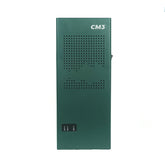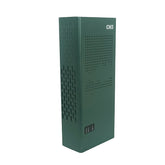Fight and shoot drones - jammers and drone defense
There are more and more drones in use in Germany, which are used in different areas to support individuals and companies in a variety of tasks. These include filming during sports, photographing weddings and checking the harvest for farmers. Also in the official area, threats provide support, for example when investigating the situation after disasters or in the event of accidents and fires.
According to estimates, there are currently between 800,000 and 1.5 million drones in use in Germany. Their exact number is difficult to estimate because there is no central drone registration, nor are crashes and faults recorded. This means that the quantity sold in the domestic market cannot be corrected for the loss.
Detection of a drone
One of the biggest hurdles in the fight against drones is their detection. If the drone is not recognized, no countermeasures can be initiated. However, detecting drones in the sky is difficult because on the one hand they can be very small depending on the size and on the other hand they are difficult to detect due to their high speed.
In the professional field, there are several approaches to recording drones. The latest technology from different fields is used to provide detection and tracking of the drone. Modern possibilities are the localization of the drone via its radio signal or the detection and tracking of flying drones via acoustic sensors. These can also record acoustics and save them to a database to make it easier to identify the drone later. Another possibility is detection of the drone via a radar system. The small size of the drone presents an additional challenge, as an approaching drone can easily be mistaken for a bird. In addition, it can be located using infrared or electro-optical sensors.
Optical detection methods can be used to a limited extent in rain and fog and can only be used with restrictions due to bad weather conditions. In these weather conditions, it makes sense to use infrared or radar systems so that you can detect drones through fog and rain. Compared to infrared, radar offers a much longer range for detecting approaching drones.
Professional countermeasures against drones
The drone market is growing rapidly, and new models with more powerful motors and a wider range of functions are constantly being introduced. The market for countermeasures against drones is growing just as fast in the background, as security devices also have to prepare for new threats. The defense technology market is at the highest technological level and is constantly introducing new innovations. There are three levels of escalation in the fight against drones.

First step - detection
The drone must first be recognized as such. For this, complex sensory systems must combine their measurement results to identify the drone as a drone using optical, infrared, radar and other sensors without being distracted by birds of similar size and speed. After detecting an object in the airspace as a drone, the second stage is started.
Second step - identification
This phase recognizes what type of drone it is. The size and, if possible, the model of the drone are identified. This can be used to derive the drone's load capacity and therefore the load it could carry. This allows an initial risk assessment to be carried out. At this point, it is not yet clear what danger the drone poses as it is not certain what the drone is carrying. Since drones move at high speed, the first two steps should be clarified very quickly in order to save time to decide on countermeasures.
Third step - countermeasure
In this phase, the risk potential of the drone is estimated by additional measurement or optical detection of the drone. Factors for this are payload, speed and recognizable attachments. Then a decision is made on the use of countermeasures.
These are divided into two categories: passive and active countermeasures. A passive countermeasure usually triggers an alarm and follows a routine when the alarm is triggered.
Active countermeasures are more serious and are in turn divided into different categories. One possibility is so-called jamming, in which the signal connection between the drone pilot and the drone is disrupted. Normally this forces the drone to land, but the programming of the drone can be changed and it can then fly out of control. Another option is spoofing, in which the drone emits a bad GPS signal and thus deviates from its path. Another category of active countermeasures is the difficult interception of drones. The use of lasers, water cannons, guns, fishing nets, kamikaze drones or powerful sounds are used to pull them out of the sky. These measures often lead to the destruction of the drone and an uncontrollable crash. It should therefore be considered as the last option, as it is not possible to ensure that the drone does not fall into crowds, especially near crowds.
Research is ongoing on other ways to render drones harmless and remove them from the skies more gently. The context here is not the conservation of drones in order to continue using them, but rather the evaluation of the drone's stored data. This data allows conclusions to be drawn about the owner, the route traveled and the equipment equipped. This data is of great value to forensics, so non-destructive drone recovery is preferred. The OpenWorks Engineering company offers a solution with the Skywall. It is visually reminiscent of a rocket launcher, which, however, throws nets into the air with compressed air, grabs the drone with it and lands safely with a parachute. In order not to have to reload for a long time in the event of a cut, the system has a loader with which several nets can be fired in succession. GroupeAssmann from France offers another possibility with its MALOU-tech drones. These very fast drones fly towards the target drone, can follow them and are equipped with a network. They can capture other drones up to 6 kg and land safely. The DroneShield company takes an additional approach with its gun-shaped drone jammer, which can launch drones remotely from the ground. In addition, eagles are currently experienced and trained to intercept drones. However, it is still unclear whether these will actually be used by the police.
What can I do with drones?
Many citizens are annoyed by neighbor drones and feel watched in the garden or on the terrace. It is also not known what happens to the photos that, for example, a neighbor takes with his drone of the other property and the people there. This can significantly reduce the quality of life and lead to psychological problems. So it is natural to think about shooting the drone. However, this is not permitted for individuals and also makes sense in the context of an uncontrollable accident.
Only military and police units are allowed to fire drones with different means to avoid danger. Individuals are only allowed to capture drones, which prevents an uncontrolled crash. Interfering with the drone signal with whining is also prohibited for individuals. If you are disturbed by the neighbor's drone, you can contact the police to clarify the situation accordingly.
There are currently no exemptions for security companies, as only state authorities and institutions can actively act against drones. A relaxation of these regulations is currently under study, as it is very difficult to ensure the safety of thousands of football fans or concertgoers, especially at large events, if private security companies are not authorized. take countermeasures against drones.













